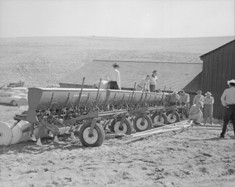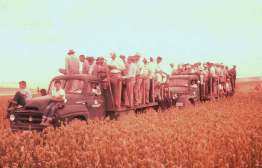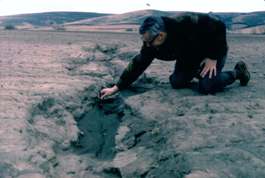ARS Home
» Pacific West Area
» Pendleton, Oregon
» Columbia Plateau Conservation Research Center
» Docs
» Historical Timeline
Historic Timeline
| Year | Event | |
|---|---|---|
| 1928 | The Pendleton Field Station was established as a cooperative project between the Oregon Agricultural Experiment Station and the U.S. Department of Agriculture under the Division of Dryland Agriculture. | |
| 1931 | The long-term tillage and rotation plots were established, and remain today as the oldest continuously managed research plots in the western United States. Cereal-breeding research was initiated at Pendleton by the USDA Division of Cereal Crops and Disease. |  |
| 1940 | Tillage and fertility experimental plots were initiated to study conservation tillage techniques and nitrogen fertilization. These plots still exist. | |
| 1948 | The research program was enlarged with funds from the USDA to do research on soil and water conservation. | |
| 1952 | All Soil Conservation Service funds transferred to the Agricultural Research Service (ARS) and administered by the Soil and Water Conservation Research Division. | |
| 1963 | Cereal/legume rotations and water requirements of crops were examined for different rainfall zones. | |
| 1965 | Congress appropriated funds to establish the Columbia Plateau Conservation Research Center (CPCRC). Facilities were completed in 1970 and staff grew from two scientists in 1965 to seven scientists in 1980. Objectives of CPCRC were defined and expanded after considerable public input. Emphasis was put on research problems pertinent to the Columbia Plateau but consistent with the national objectives of the ARS. | |
| 1965-1985 | Water use data from long-term plots provides information to create agroclimatic zones maps for the Pacific Northwest. |  |
| 1977-2000 | Cereal leaf, tiller, and root developmental research leads to MODWHT, a wheat growth model. | |
| 1975-Present | Use of the long-term plots allows in depth studies of effects of management on soil properties and carbon sequestration. Long-term changes in soil organic matter content and quality influenced by crop rotation, tillage and crop productivity were defined using the long-term plots. Runoff and erosion plots provided data to improve the Revised Universal Soil Loss Equation, and to better define water and sediment quality as related to management. | |
| 1980-1985 | Identification of non uniform chaff and straw distribution by practically all combines during harvest led to rapid improvement in residue dispersal systems and much improved drill performance and crop growth in no-till systems. | |
| 1999-Present | Research on mechanical manipulation of residues has led to better seedling emergence and vigor, and improved no-till drill performance. | |
| 2000-Present | An improved residue management method was developed using ground-driven rubber fingered wheels that attach to no-till drills and pin residue to the soil surface thus preventing the residue from lodging on the furrow opening tines and plugging the drill. | |
| 2004 | By incorporating soil texture class, drainage class, and harvest operation, the carbon sequestration model (CQESTR) is improved thus making it one of the most widely used agronomic models for assessing crop production methods and their influence on soil carbon storage and potential to mitigate greenhouse gas emissions. |  |
| Paired watersheds are used to effectively demonstrate the benefits of conservation tillage in controlling soil erosion. | ||
